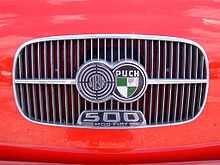Puch 500

Puch 500 was a small car produced by Steyr-Daimler-Puch in the city of Graz, Austria. It was manufactured under licence from Fiat and was based on the Fiat 500.
The beginning
In 1954 it was decided at Steyr-Puch to resume car production after the war. Because of the high costs associated with the development of a completely new design, an agreement was made with Fiat to acquire and adapt the body in white of their Fiat 500-model. Of the body, only the engine cover and later the roof was produced in-house. On the other hand engine, transmission and carriage were all manufactured by Steyr-Puch. The engine was a two-cylinder (16 hp/12 kW) flat engine which proved to be far more smooth running than the in-line engine used by Fiat. It brought for that time good driving behaviour, especially in mountain rides. The first Steyr-Puch 500 was launched in 1957 and it was a hit. At first it was offered only with a folding roof and it was anticipated as a draw from motorcyclists as a buying audience. The 'Puchwagen' as it was called, was the official car for the Austrian AA-service.
Development
In 1959 came the first revision. The model Steyr-Puch 500 D was provided with a tin roof (D for Dach, roof in German), and in addition to that the model 500 DL was equipped with a stronger motor (20 hp/15 kW). 1961 saw the launch of two estate models, 700 C (C for Combi) and 700 E (E for Economy), both featuring a larger motor but with different power ratings. In 1962 also the sedan was equipped with the larger motor, leading to the 650 T (T for Thondorf, the location of the plant). A few years later the motor was boosted even more, resulting in the models 650 TR and 650 TR II (R for Rallye) – models at first intended for police use, but later also offered as standard. Up until now the body and outfit had remained more or less the same, but in 1967 the modified body that Fiat 500 had introduced 1965 was assumed also in Graz. The most essential new feature was the front hinged doors as opposed to the former suicide doors. As of then also the roof was adopted from Fiat. The new models became the additional label “Europa”. In 1969, due to decreasing demand, it was decided to adopt not only the body but the whole drive unit from Fiat. The motor was the only unit to remain under own manufacture and the model was now called 500 S (Sport), Eventually, in 1974, was the successor model from Fiat, model 126, adopted in Graz. Also here one restricted oneself essentially to fitting the Puch motor in the otherwise nearly finished car. As early as the following year production was stopped due to diminishing demand. With a yellow 650 TR Gerard van Lennep won the Production Cars Championship (up to 700 cc.) of the Netherlands in 1966 and 1967. He competed as well in Europacup races, winning in Belgrade.
The small car sold well, with around 60,000 units produced between 1957 and 1975. Despite restrictive licensing clauses from Fiat, quite a few cars were exported outside Austria, most of them to Germany, Finland and Hungary.
| Type | Production year | cc | Power |
|---|---|---|---|
| 500 | 1957–1959 | 493 | 16 hp (12 kW) |
| 500 D | 1959–1967 | 493 | 16 hp (12 kW) |
| 500 DL | 1959–1962 | 493 | 20 hp (15 kW) |
| 700 C (Combi) | 1961–1968 | 643 | 25 hp (18 kW) |
| 700 E (Combi) | 1961–1968 | 643 | 20 hp (15 kW) |
| 650 T | 1962–1968 | 643 | 20 hp (15 kW) |
| 650 TR | 1964–1968 | 660 | 27 hp (20 kW) |
| 650 TR II | 1965–1969 | 660 | 41 hp (30 kW) |
| 500 S | 1967–1973 | 493 | 20 hp (15 kW) |
| 126 | 1973–1975 | 643 | 25 hp (19 kW) |
Gallery
| Wikimedia Commons has media related to Puch 500. |
-

-
-
-

Steyr-Puch, built in 1964 at the DAMC 05 Oldtimer Festival Nürburgring

